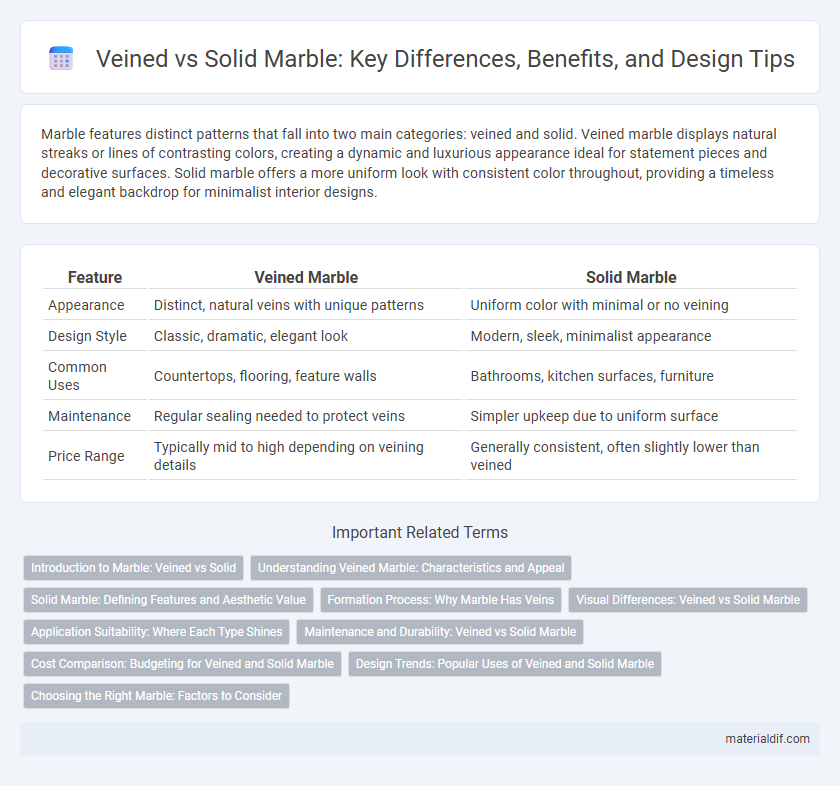Marble features distinct patterns that fall into two main categories: veined and solid. Veined marble displays natural streaks or lines of contrasting colors, creating a dynamic and luxurious appearance ideal for statement pieces and decorative surfaces. Solid marble offers a more uniform look with consistent color throughout, providing a timeless and elegant backdrop for minimalist interior designs.
Table of Comparison
| Feature | Veined Marble | Solid Marble |
|---|---|---|
| Appearance | Distinct, natural veins with unique patterns | Uniform color with minimal or no veining |
| Design Style | Classic, dramatic, elegant look | Modern, sleek, minimalist appearance |
| Common Uses | Countertops, flooring, feature walls | Bathrooms, kitchen surfaces, furniture |
| Maintenance | Regular sealing needed to protect veins | Simpler upkeep due to uniform surface |
| Price Range | Typically mid to high depending on veining details | Generally consistent, often slightly lower than veined |
Introduction to Marble: Veined vs Solid
Marble is characterized by its unique surface patterns, primarily categorized into veined and solid types. Veined marble features distinctive, flowing veins that create intricate, natural patterns, often found in varieties like Carrara and Calacatta. Solid marble presents a more uniform color and texture, offering a sleek and consistent look ideal for minimalist designs.
Understanding Veined Marble: Characteristics and Appeal
Veined marble features natural streaks and patterns created by mineral impurities, offering a dynamic and artistic aesthetic that appeals to luxury interior designs. Its unique, flowing veins vary in color and thickness, enhancing visual interest and depth compared to solid marble's uniform appearance. This distinctive characteristic makes veined marble a preferred choice for statement surfaces, adding elegance and sophistication.
Solid Marble: Defining Features and Aesthetic Value
Solid marble is characterized by its uniform color and consistent texture, offering a sleek and minimalist aesthetic that enhances architectural and design projects. Its durability and timeless appeal make it a preferred choice for flooring, countertops, and wall cladding, providing a seamless and elegant look. The subtlety of solid marble allows it to complement various interior styles, creating a sophisticated ambiance without overwhelming the space.
Formation Process: Why Marble Has Veins
Marble's veins form due to the presence of mineral impurities like iron oxides, clay, or silt that were present during the metamorphic recrystallization of limestone. These impurities undergo chemical changes under high temperature and pressure, creating intricate vein patterns throughout the marble. Solid marble, by contrast, lacks significant mineral impurities, resulting in a uniform appearance without veining.
Visual Differences: Veined vs Solid Marble
Veined marble is characterized by intricate, flowing patterns created by mineral deposits, offering dynamic and luxurious visual interest with natural streaks in various colors. Solid marble, by contrast, features a more uniform, consistent appearance with minimal to no visible patterns, resulting in a sleek and minimalist aesthetic ideal for contemporary designs. The choice between veined and solid marble depends largely on desired visual impact and decor style, with veined marble emphasizing texture and movement while solid marble highlights simplicity and elegance.
Application Suitability: Where Each Type Shines
Veined marble is ideal for decorative applications such as countertops, backsplashes, and feature walls where its natural patterns create a distinctive visual impact. Solid marble suits flooring and large surface areas, offering a clean, uniform appearance that enhances minimalist and modern designs. Both types excel in different architectural contexts, with veined marble adding texture and character, while solid marble provides a sleek, consistent aesthetic.
Maintenance and Durability: Veined vs Solid Marble
Veined marble often requires more maintenance due to its intricate patterns which can obscure scratches but make stains more noticeable, necessitating regular sealing to preserve durability. Solid marble exhibits uniform coloration that typically shows wear and scratches more clearly but tends to be more durable over time with less frequent maintenance. Proper care including sealing, cleaning with pH-neutral products, and timely repairs is essential for both veined and solid marble to maintain their structural integrity and aesthetic appeal.
Cost Comparison: Budgeting for Veined and Solid Marble
Veined marble generally commands a higher price due to the complexity and variability of its natural patterns, while solid marble tends to be more affordable with a consistent color and texture. The cost difference can also be influenced by factors such as rarity, quarry location, and slab size, with veined varieties like Calacatta or Arabascato often priced above solid options like Carrara. When budgeting, homeowners should consider installation and maintenance expenses, as veined marble may require more careful handling to preserve its intricate veins, potentially increasing overall costs.
Design Trends: Popular Uses of Veined and Solid Marble
Veined marble is favored in contemporary interior design for its dynamic patterns that create focal points on countertops, feature walls, and flooring, enhancing visual interest in kitchens and bathrooms. Solid marble, with its uniform appearance, is popular for minimalist and modern spaces, providing a sleek, elegant backdrop ideal for large slabs in tabletops and wall cladding. Both types are highly valued for luxury residential and commercial projects where durability and timeless beauty are essential.
Choosing the Right Marble: Factors to Consider
Choosing the right marble involves evaluating whether veined or solid patterns best suit the intended space, considering aesthetics, maintenance, and durability. Veined marble offers unique, natural patterns that can become a focal point, ideal for statement walls or countertops, while solid marble provides a uniform look for minimalist or contemporary designs. Assess factors such as color consistency, susceptibility to staining, and how the marble complements existing decor to make an informed selection aligned with both style and longevity.
Veined vs Solid Infographic

 materialdif.com
materialdif.com